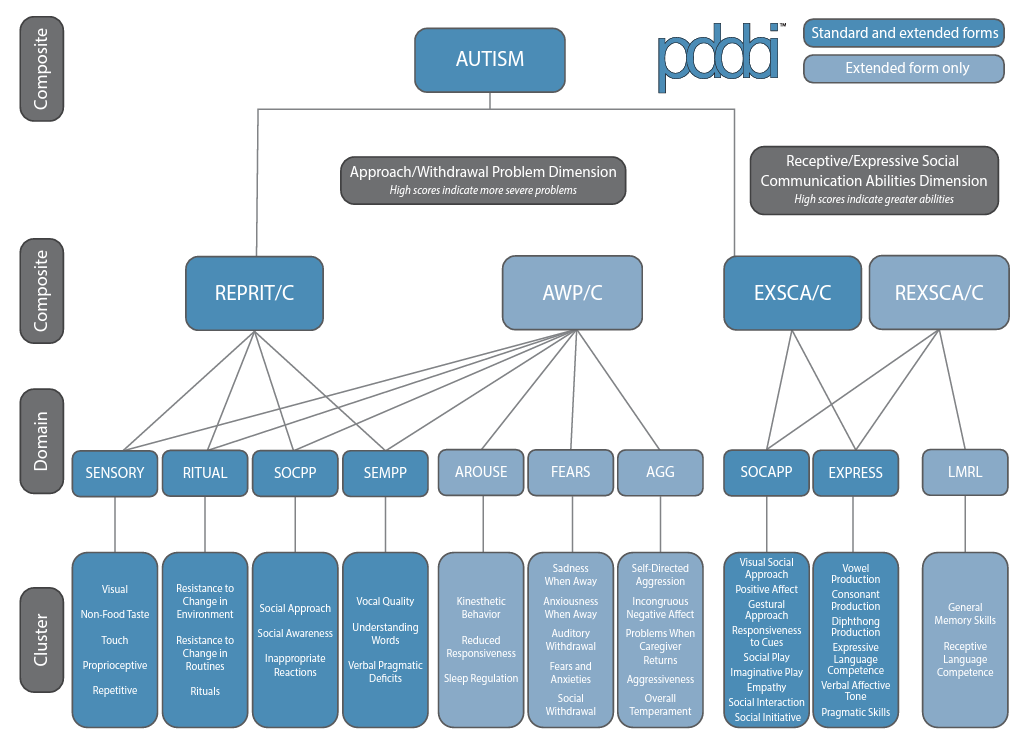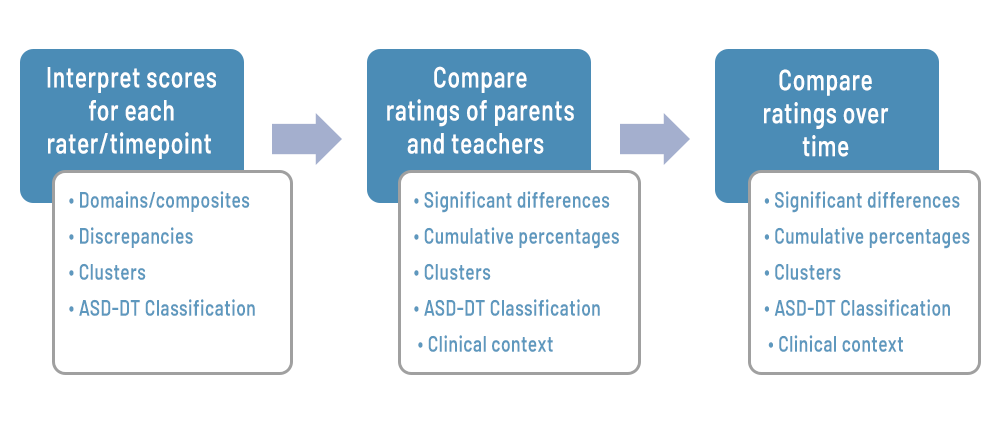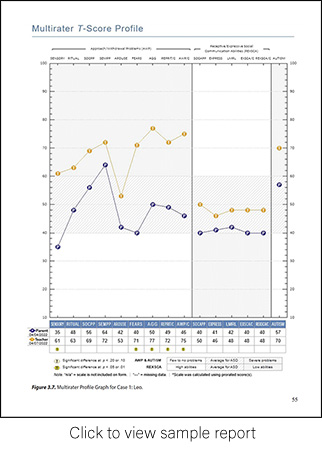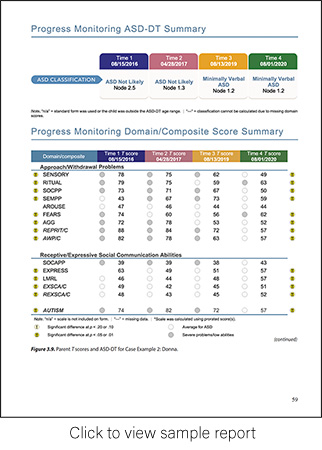Register now and start:
- Accessing PAR Training
- Shopping PAR products & tools
- Using online assessments with PARiConnect
The PDDBI was developed with several primary goals in mind:
PDDBI Professional Manual Supplement: Advanced Score, Multirater, and Progress Monitoring Interpretation
This supplement provides new guidance for calculation and interpretation of parent–teacher rating comparisons and tracking changes in scores over time, using Reliable Change Indices. In addition, it includes guidance for advanced interpretation of the PDDBI, from interpreting individual scores and clusters to comparing parent and teacher ratings and tracking scores over time. This manual supplement applies to ages 1:6 to 18:5 years.
PDDBI Professional Manual Supplement: Autism Spectrum Disorder Decision Tree (ASD-DT)
The ASD-DT is designed to enhance the diagnostic power of the PDDBI. Once a parent or teacher has completed the Extended Form, the ASD-DT allows you to use those scores to complete the branches of a decision tree that ultimately results in a diagnostic category. An algorithm is used to transform PDDBI scores into subgroups of ASD (Atypical ASD, Minimally Verbal ASD, or Verbal ASD) as well as non-ASD subgroups. Intervention suggestions and further recommendations are provided for all subgroups. The ASD-DT is designed to be used with individuals ages 1:6 to 12:5 years. PARiConnect reports automatically include the ASD-DT report when appropriate.
PDDBI Professional Manual Supplement: Adolescent Normative Data
This supplement extends the age range of the PDDBI normative data to age 18:5 years. Ideal for use when monitoring progress over time, this extension to the normative data can be used with both parent and teacher ratings on the PDDBI. The standardization sample includes individuals from a range of racial and ethnic backgrounds and geographic regions. The adolescent normative data are appropriate for use when either the standard or extended items are administered. The normative data are available on PARiConnect reports.
Supplemental material from PDDBI author Ira L. Cohen explains how to use the Autism Spectrum Disorder Decision Tree with the PDDBI for screening and intervention planning. A second white paper explains the creation and use of the new Spanish translation of the PDDBI Parent Form. Visit the Resources tab above to view or download.


More information can be found in the PDDBI Professional Manual Supplement: Advanced Score, Multirater, and Progress Monitoring Interpretation.
 This supplement to the PDDBI manual is unique. It explains in detail how to select informants, how to use PARiConnect to administer the PDDBI, how to interpret raw, cluster, and T- scores, how to properly score non-verbal children, how to interpret and examine the statistical significance of differences in T-scores across parent and professional informants, how to use the ASD-Decision Tree (ASD-DT) to assist with diagnostic and referral decisions, and how to examine and interpret the statistical significance of differences in T-scores over time from the same informant for a given child. One of our independent reviewers said, 'I usually do not enjoy reading manuals, but this one was very engaging.' I hope you too find this addendum to the PDDBI engaging and helpful.
This supplement to the PDDBI manual is unique. It explains in detail how to select informants, how to use PARiConnect to administer the PDDBI, how to interpret raw, cluster, and T- scores, how to properly score non-verbal children, how to interpret and examine the statistical significance of differences in T-scores across parent and professional informants, how to use the ASD-Decision Tree (ASD-DT) to assist with diagnostic and referral decisions, and how to examine and interpret the statistical significance of differences in T-scores over time from the same informant for a given child. One of our independent reviewers said, 'I usually do not enjoy reading manuals, but this one was very engaging.' I hope you too find this addendum to the PDDBI engaging and helpful.
- Ira L. Cohen, PhD
 I developed the PDDBI to assist both clinicians and researchers in assessing children on the autism spectrum (ASD). The new Multirater and Progress Monitoring Reports along with the recently enhanced Score Report provide information in great detail and in an easy-to-understand format that can be used to provide feedback to families and referring professionals. I recommend you use these reports to help you:
I developed the PDDBI to assist both clinicians and researchers in assessing children on the autism spectrum (ASD). The new Multirater and Progress Monitoring Reports along with the recently enhanced Score Report provide information in great detail and in an easy-to-understand format that can be used to provide feedback to families and referring professionals. I recommend you use these reports to help you:
Yes. The PDDBI is approved by TRICARE for use by ABA therapists. According to the ACD, TRICARE requires the following age-based outcome measures for beneficiaries at initial assessment and every six months:
PAR publishes two other tests that evaluate parent stress and are part of the ACD program.
PAR distributes the SRS-2 which is also part of the Autism Care Demonstration program.
Please visit the TRICARE website for more information about autism tests.

Background
Leo was evaluated at 6 years, 11 months of age for diagnostic confirmation of autism. Leo's PDDBI parent report was consistent with the diagnosis of ASD, with an atypical ASD profile characterized by relatively mild- to- moderate behavior problems and relatively weak social communication skills. His teacher's ratings resulted in a classification of Minimally Verbal ASD characterized by more severe problem behaviors.
Test Results

The T-Score Profile in the new PDDBI Multirater Report illustrates the cross-informant agreement (i.e., non-significant differences) on several domains under Approach/Withdrawal Problems (AWP) and on all the Receptive/Expressive Social Communication Abilities (REXSCA) domains. However, there were significant discrepancies (marked below the profile with "!!" icons) between parent and teacher reports in three of the AWP domains (SENSORY, FEARS, and AGG) and both associated composites (REPRIT/C and AWP/C). The profile indicates that the parent reported fewer problems at home (T scores in the average range for autism) than the teacher did at school (T scores in the range of severe problems).
Outcome
Examination of each informant's cluster scores later in the report indicated marked discrepancies in several areas, including auditory and social withdrawal behaviors, problems with caregiver return, and aggressiveness toward others. Supplemental information from Leo's parents and teacher indicated that noise levels at school and Leo's intolerance for change likely played a role in these differences between settings. Understanding the differences between settings helped his school team develop a specific plan to help his teacher manage his behaviors and mitigate his distress.
**************************************************************************

Background
Donna was first referred around age 2 years because of delayed milestones and irritable behaviors. Over the next few years repeat assessment indicated little progress with intervention, and she was eventually diagnosed with and treated for inflammatory bowel disease. She was re-assessed a third time just before she turned 5 years old; she was diagnosed with autism, and her PDDBI at that time showed ongoing concerns with expression language and social skills.

Test Results
Donna was evaluated for a fourth time with the PDDBI one year later, when she was almost six years old, to assess for treatment gains and to help update her therapy needs. Compared to her evaluation one year prior, Donna’s PDDBI T scores showed significant improvements (denoted by “!” and “!!” icons in the score table, with the “4” icon consistently indicating that time 4 scores were significantly better) in problem behaviors in three AWP domains and the accompanying composite. In each case, the magnitude of change was seen in only small percentages of the progress monitoring sample (less than 7%), indicating that this magnitude of change is unexpected in the absence of intervention. In the REXSCA dimension, the EXPRESS and LMRL domains showed significant improvements in abilities, as did both composites. A significant decrease in the overall AUTISM composite reflected these improvements.
Outcome
These gains were directly related to her ongoing treatment without the interference of medical symptoms, as her bowel condition had been successfully treated, and they had been targeting social prag¬matics and sensory tolerances with behavioral desensitization over the previous year. Her evaluating clinician recommended maintaining several of her treatment goals and setting additional goals for expressive language and social overtures.